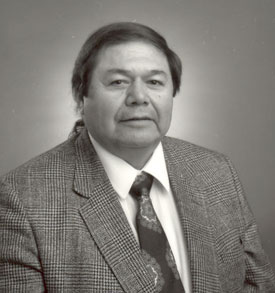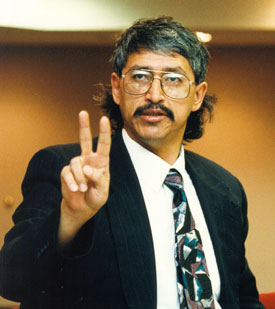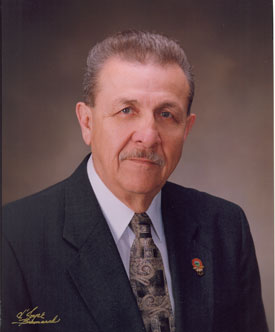Introduction
Following the passage of the Indian Reorganization Act of 1934, the Mandan, Hidatsa, and Arikara adopted a constitution on May 15, 1936. Under the Indian Reorganization Act (IRA), the Tribes adopted a form of the American political governance structure. This form of government, however, was not new to the Three Affiliated Tribes. While the new constitution provided for a tribal council to replace the old business committee, the tribes had been operating under a representative form of government established in 1910. Prior to 1910, each village had individual leaders whether born into a leadership position or not. Voting was by consensus originating from each village. With the governance structure established in 1910, individuals were selected to represent each tribe and not village.
The old business committee had consisted of equal representation from each tribe, two members each from Shell Creek and Nishu (formerly called Armstrong) and one each from Santee (Lucky Mound), Ree (Beaver Creek), Independence, Elbowoods, Little Missouri, and Red Butte. The new council was essentially the same. However, prominence was afforded leaders on the business council who carried out the operations of the Three Tribes.
The following list is a compilation of the leaders of the Tribal Business Council beginning with the Three Tribes adoption of the Indian Reorganization Act constitution in 1934. Many leaders of the tribe exist, who are not recognized as public officials (e.g. society members, medicine people, sacred bundle carriers, skilled artisans, and tellers of sacred stories), and have not been listed. However, it is important to understand that these individuals remain highly valued leaders and protectors of the tribe. These individuals, in some cases, direct the actions of tribal business leaders.
Fort Berthold Tribal Chairpersons in Order of Service*
| CHAIRMAN | BORN | DIED | SERVED |
| Arthur Mandan | 1882 | 03/22/1955 | Sept. 1936–Aug. 1938 |
| Martin Levings | 10/14/1892 | 10/26/1974 | Sept. 1938– Aug. 1940 |
| Albert Simpson | 1882 | 05/11/1957 | Sept. 1940– Aug. 1942 |
| Peter Beauchamp | 06/15/1877 | 08/07/1960 | Sept. 1942– Aug. 1944 |
| Martin Cross | 05/08/1906 | 04/04/1964 | Sept. 1944– Aug. 1946 |
| George Gillette | 11/03/1902 | 10/04/1985 | Sept. 1946– Aug. 1948 |
| Carl Whitman | 03/06/1913 | 01/19/1995 | Sept. 1948– Aug. 1950 |
| Martin Cross | 05/08/1906 | 04/04/1964 | Sept. 1950– Aug. 1952 |
| Martin Cross | 05/08/1906 | 04/04/1964 | Sept. 1952– Aug. 1954 |
| Martin Cross | 05/08/1906 | 04/04/1964 | Sept. 1954– Aug. 1956 |
| Carl Whitman | 03/06/1913 | 01/19/1995 | Nov. 1956– Aug. 1958 |
| James Hall | 06/24/1894 | 10/17/1977 | Sept. 1958– Aug. 1960 |
| Robert Fox | 01/05/1915 | 02/10/1982 | Sept. 1960– Aug. 1962 |
| Carl Whitman | 03/06/1913 | 01/19/1995 | Sept. 1962– Aug. 1964 |
| Robert Fox | 01/05/1915 | 02/10/1982 | Sept. 1964– Aug. 1966 |
| August Little Soldier | 08/15/1914 | Present | Sept. 1966– Aug. 1968 |
| Vincent Malnourie | 03/21/1910 | 02/17/1979 | Sept. 1968– Aug. 1970 |
| Ralph Wells Jr. | 08/15/1908 | 02/02/1971 | Sept. 1970– Dec. 1971 |
| Nathan Little Soldier | 04/22/1918 | 04/19/1980 | Sept. 1971– Aug. 1972 |
| Rose Crow Flies High | 02/22/1918 | 01/09/1994 | Sept. 1972–Oct. 1972 |
| Vincent Malnourie | 03/21/1910 | 02/17/1979 | Oct. 1972– Nov. 1974 |
| Rose Crow Flies High | 02/22/1918 | 01/09/1994 | Oct. 1974– Oct. 1978 |
| Austin Gillette | 09/20/1946 | Present | Nov. 1978– Oct. 1982 |
| Alyce Spotted Bear | 12/17/1945 | Present | Oct. 1982– Apr. 1986 |
| Edward Lone Fight | 05/28/1939 | Present | April 1986– Nov. 1990 |
| Wilbur Wilkinson | 10/12/1948 | Present | Oct. 1990– Nov. 1994 |
| Russell Mason | 03/23/1936 | 01/14/2009 | Oct. 1994– Nov. 1998 |
| Tex Hall | 09/19/1956 | Present | Nov. 1998– Nov. 2006 |
| Marcus D. Levings | ---- | Present | Nov. 2006 – Nov. 2010 |
| Tex Hall | 09/19/1956 | Present | Nov. 2010 - Nov. 2014 |
| Mark Fox | Present | Nov. 2014 - Present |
1936-1960
Tribal Leaders, 1936 - 1960
ARTHUR MANDAN
Mandan/Hidatsa, 1936–1938
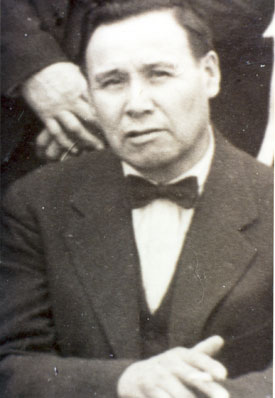
Arthur Mandan, Woman Spirit, was born in 1882 to Calf Woman and Howard Mandan, Sr., Scarred Face, who was one of the first Mandans to go to an Indian boarding school in Santee, Nebraska. As a young man, he attended school at Carlisle Indian School in Pennsylvania where he was a member of the school band, a skill he continued throughout his adult life. He returned to Fort Berthold Reservation in 1908. Hereditary chief of the Mandan, he was the first tribal chairman of the Three Affiliated Tribes to serve (September 1936 to August 1938) after the Three Tribes accepted the Indian Reorganization Act. He represented the district of Independence.
A civic-minded man, Arthur Mandan was a liaison and interpreter for early ethnographers such as Beckwith and Bowers. In addition, he was a musician in Washburn, North Dakota for a number of years and was in a band that played at many reservation functions. He also drafted the bylaws and constitution for the Three Tribes, establishing credit programs, and negotiating claim and dust bowl recovery programs. He spoke fluent Mandan, Hidatsa, and English and served as interpreter for many years. He was prominent among Catholic parishioners on the Fort Berthold Reservation, interpreting sermons and speeches into Hidatsa and Mandan and translating Catholic hymns into the Hidatsa language. He was the first Indian teacher in Washburn, North Dakota, where he taught music. He was appointed as a tribal judge, and was well known as an announcer at many public functions. He announced at the last celebration at Elbowoods before the flooding of the bottomlands for the Garrison Dam.
In January of 1938, he accompanied and interpreted for Drags Wolf and Foolish Bear when they went to New York City to the Heye Museum to recover and return the sacred bundle of the Waterbuster Clan to the Hidatsa. On their return, they met with President Franklin D. Roosevelt in Washington, D.C. (“Indian Tribes,” 1853). He married Anna Young Bird in 1913, and they ranched at Independence. They also had a home at Lucky Mound where their children attended school. They moved to Mandaree in 1953. (“Anna Mandan” 1983) He died in March of 1955 at the age of 73. (Mandan, 73, Indian Leader, 1955)
MARTIN LEVINGS
Hidatsa, 1938–1941
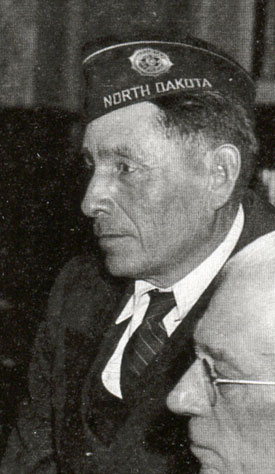
Martin Levings, Ah-pa-hi-si-pi-sas “Black Cloud” was born to Hard Horn and Looking for Medicine on October 14, 1892. He was a member of the Knife Clan. He and his wife, Ruth, adopted two children and ranched in the western part of the reservation.
He joined the Army in 1918, was injured in Europe, and was discharged in 1919. He moved to Wibaux and Livingston, Montana. He married Vincentia Ring and for a number of years was a rancher and farmer in the Shell Creek area. (Martin Levings Obituary, 1974)
After the death of his wife, he moved back to the reservation. Martin Levings represented the community of Independence on the Tribal Business Council and served as chairman from 1938 to 1940. He moved to New Town in 1960 and for several years he was an active member and commander of the American Legion Post No. 300 of the Little Shell District, and a member of the Mandaree VFW. He died October 27, 1974, at the age of 82. (Legion Post Names, 1962)
ALBERT H. SIMPSON
Sahnish, 1940–1942
Albert Simpson was born in 1888. Albert’s father, White Breast, whose Indian name was Sayedda and his uncle Thomas H. Suckley or Kawhat, whose Indian name was Bow Legs, were two of the first nine Fort Berthold students to attend Hampton Institute. Albert’s stepfather was George Wilde. Simpson attended the government boarding school at Fort Stevenson for five years and Fort Berthold for two years. He was sent to Hampton in 1898 and left in 1901. He graduated from Carlisle School in 1907. He enrolled in the business department at Haskell Institute, Kansas from 1907 to 1909. In 1911 he was appointed postmaster at Elbowoods, North Dakota and in 1914 was blacksmith in the Elbowoods area. (Hultgren, 1994) Albert Simpson served on the tribal business committee from 1940 to 1942.
PETER BEAUCHAMP, JR.
Sahnish, 1942–1944
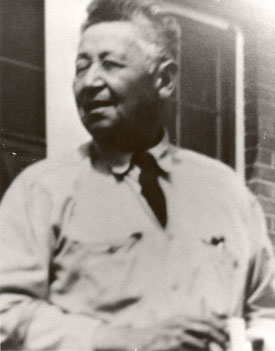
Peter H. Beauchamp II was born on June 15, 1877 on the Fort Berthold Reservation. His Sahnish name was Big Rock. His father was Peter Beauchamp Sr., and his mother was Woman Goes Out. He married Adeline Z. Powell, a missionary with the Congregational Church, and was hired by the Bureau of Indian Affairs as a school teacher at Shell Creek. He was an interpreter and recordkeeper for the tribes. He was instrumental in establishing the reservation educational system, sports programs, and implementing the allotment program. He served as a teacher and farm boss. Fluent in Sahnish, Mandan, Hidatsa, and English, Beauchamp often served as an official interpreter on behalf of the tribes, traveling to Washington, D.C. on numerous occasions. In those days, funds had to be raised from community resources. He was an interpreter for Melvin Gilmore on the Arikara Genesis. He maintained a detailed diary of his business and accounted for his expenditures and his time. (Hall, 1977, p. 47) He helped develop several Fort Berthold land claims.
He was a leader of the Tribal Business Council for many years serving as chairman from 1942 to 1944. Under his leadership, the tribe secured pensions for 148 young Sahnish men, who were scouts and dispatchers for the U.S. Government. He organized the Old Scouts Society, and provided for the designation of the Old Scouts Cemetery at Like-A-Fishhook Village.
In later years, he was a road foreman for the Bureau of Indian Affairs and court judge for the U.S. Indian Service. He was a rancher, farmer, and superintendent of the Sahnish Congregational Sunday School at White Shield. He died August 27, 1960. (Beauchamp Obituary, 1960)
MARTIN CROSS
Mandan and Hidatsa, 1944–1946, 1950–1952, 1952–1956*
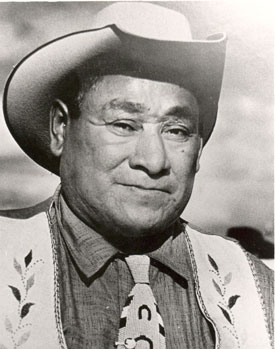
Martin Thomas Old Dog, Sr., was born on May 8, 1906. His father was Chief Old Dog and his mother was Many Dances. He and his wife raised six sons and four daughters. He attended school at Flandreau Indian School in South Dakota and Wahpeton Indian School in North Dakota. (Bureau of Indian Affairs, Enrollment Records) He was a fluent speaker of Hidatsa and Mandan.
In 1942 he changed the family name from Old Dog to Cross. He was commander of the Joseph Young Hawk Post at Elbowoods. He served his first term from 1944–1946 representing the district of Elbowoods. He served two additional terms, from 1950–1952. During his third term in office, 1952–1954, the constitution of the tribe had to be changed before the 1954 election. The Bureau of Indian Affairs conducted the election. Not enough people turned out for the election, so the elected tribal council stayed on for the four years during the transition.
He was founder of the North Dakota Council of Indian Tribes (NCAI) serving as its president in the early 1950s. (Cross Heads, 1954) He was among the original founders of the National Congress of American Indians and served as their vice president in 1953. He was re-elected to the Executive Council of NCAI in 1954. (Indian Congress, 1954)
He was actively involved in efforts to halt the construction of the Garrison Dam. His administration saw the distribution of the final payment of remaining funds due the Three Affiliated Tribes from their settlement with the government for losses sustained by construction of the Garrison Dam. He was also closely involved with reorganizing the tribe after the construction of the Dam. He opposed the termination movement in the mid-1950s. He died on April 7, 1964. (Martin Cross Obituary, 1964)
GEORGE GILLETTE
Sahnish, 1946–1948
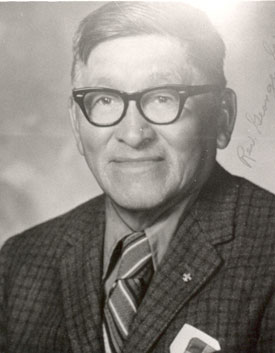
George Gillette was born October 29, 1902, on the Fort Berthold Reservation. He attended Bismarck Indian School, Flandreau Indian School in South Dakota, and Haskell Institute in Lawrence, Kansas. He studied carpentry at Haskell Institute, graduating with the class of 1926. He married Evelyn Wilkinson in 1930 and lived at Beaver Creek where he farmed and ranched. They raised two sons and seven daughters.
Gillette was elected in 1946 representing the Beaver Creek district. He served as chairman during the critical period when the Three Affiliated Tribes negotiated with the U. S. Corps of Engineers over the Garrison Dam. (Gillette Recalls, 1973) During his career, he worked for the Bureau of Indian Affairs, was a lay minister for the United Church of Christ, and was a member of the North Dakota National Guard and the Dead Grass Dance Society. He was tribal judge for eight years from 1974 to 1982. He died on October 3, 1985 at the age of 82. (George Gillette Obituary, 1985)
CARL WHITMAN, JR.
Mandan/Hidatsa, 1948–1950, 1956–1958, 1962–1964
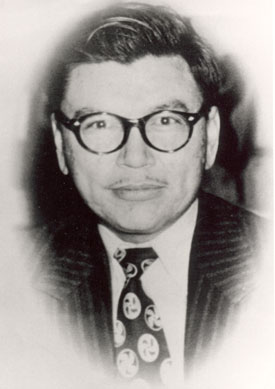
Carl Whitman Jr. was born near Elbowoods on March 6, 1913 and was reared by his grandparents. At an early age he was sent to a government boarding school. After completing his elementary years, he attended the State School of Science at Wahpeton, North Dakota where he obtained a degree in Business Administration. He returned to Fort Berthold where he raised cattle and ranched. He participated in rodeos near Lucky Mound. He worked for the Bureau of Indian Affairs at Elbowoods for years. He married Edith Lykken and had six children.
In 1948, at the age of 35, he was elected chairman of the Three Affiliated Tribes representing the Lucky Mound district. He served from 1948 to 1950. From 1950 to 1956, he served on the Tribal Business Council. In 1956, he was re-elected as tribal chairperson. In 1962, he ran again and was elected for a third term.
While chairperson, he also served as president of the National Congress of American Indians, advisory board member of the Greater North Dakota Association, the North Dakota Economic Development Commission, the North Dakota Governor’s Manpower Commission, the Advisory Committee of the North Dakota Stockman’s Association, and was a three-term president of the Greater Lake Sakakawea Association. (Whitman to Seek, 1963) He was involved in the formation of United Tribes Development Corporation, and served as its secretary and executive director.
Upon leaving tribal government, he worked as a teacher at Arizona State University, Tempe, Arizona, and was a field coordinator for its Vista program. In 1981, he retired from public life and pursued a path of spiritual renewal. In his role as a tribal spiritual leader he participated at sun dances and attempted to revive the Mandan Okipa Ceremony. He spoke Mandan, Hidatsa, and Sahnish. (Salter, “Fort Berthold loses,” 1995)
He was an inventor and talented musician. An eloquent spokesperson for his people, Whitman died January 19, 1995.
JAMES HALL (Iron Bear - Nagh Bitsi Usahas)
Hidatsa, 1958–1960
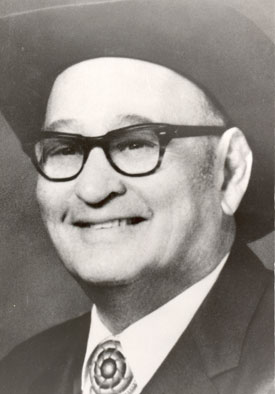
James Hall was born June 24, 1895, to Edward S. Hall and Celeste Malnourie at the trading post they owned and operated at White Earth. He married Sarah Adelia Fredricks on January 6, 1916. They farmed and ranched along the Little Missouri River, where they raised a family of five sons, four daughters, and two adopted grandchildren. In 1951, they moved to Mandaree, North Dakota. (James Hall, Sr., 1977)
James Hall served 10 years as a councilman beginning in 1946 representing the West Segment on the Tribal Business Council. He became chairman in September of 1958 and served until August of 1960. He traveled often to Washington, D.C. to negotiate terms concerning the construction of Garrison Dam. (Tribes Name, 1958) He also was an original member of the Tribal Housing Authority Board. A quiet man, he died in 1977.
1960-1986
Tribal Leaders, 1960 - 1986
ROBERT FOX (Roaming Wolf)
Sahnish, 1960–1962, 1964–1966
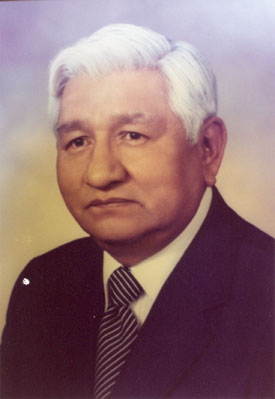
Robert L. Fox was born on January 5, 1915 at Nishu, North Dakota, the son of Fred and Hannah Wash Fox, “Choke Cherry Woman.” He attended school in Pierre, South Dakota and Santee Normal School in Santee, Nebraska. He also attended Cook Christian Training School, Phoenix, Arizona, and the University of New Mexico in Albuquerque. He married Naomi Johnson, April 8, 1936, at Center, Nebraska. He raised a family of two boys and four girls.
For 32 years, he served as pastor of Congregational churches on the Fort Berthold Reservation. He was director of the Council of American Indian Ministries of the United Church of Christ for seven years. During this time, he became involved in tribal council activities, serving four terms on the Tribal Business Council and two terms as tribal chair. He represented the East Segment. (Robert Fox Wins, 1960)
He served on the North Dakota Indian Affairs Commission, White Shield School Board for 21 years, and eight terms on the United Tribes Technical College Board of Directors (then United Tribes Employment Center Board) in Bismarck, North Dakota. He was also the first tribal chairperson to serve on the Governor’s envoy to the Conference on Indian Affairs for the United States and Canada. He retired in 1976 and died in February of 1982. (Reverend Robert Fox, 1982)
AUGUST LITTLE SOLDIER
Sahnish/Mandan, 1966–1968
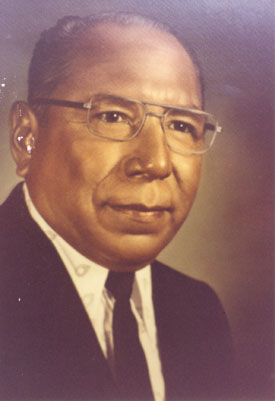
August Little Soldier’s father was Clarence Little Soldier and his mother’s name was Willena Young Bear. (Willena Little Soldier Obituary, 1984) August Little Soldier was elected to the Tribal Business Council in 1966. He represented the district of Beaver Creek. While in office, Little Soldier was an advocate for creating a strong economic infrastructure for the tribes. His administration secured tribal homes and supported the need for reservation access roads. (Indians Trying, 1968) He worked toward the creation of Four Bears Park (Fort Berthold, 1968) and initiated many human resources development projects. (Indians Trying, 1968) He was one of the founding members of United Tribes Educational Technical Center (now United Tribes Technical College). He was actively involved in negotiations with the four-company consortium constructing the Great Plains Coal Gasification Plant near Beulah. He served on a committee studying the social and economic impact of the plant and was instrumental in securing a commitment to hire American Indians. (Seiser, “Citizens Wondering, 1981) In 1966, he was appointed to the National Indian Education Advisory Board and served through 1971. He also served as chairman of the Council of American Indian Ministries (1962–1970), and was a board member of the United Church of Christ, a position he held for ten years. He was the first American Indian elected to such a high post in any American church. (Bennett, “Indian Head,” 1971)
In 1978, August Little Soldier was elected as vice-chair of the council and served in that position from 1978 to 1981. Upon leaving office, he was instrumental in establishing the first All American Indian Rodeo Association.
Today, he is sought after and recognized as an authority on the Knife River villages. He is one of the last keepers of one of the Dead Grass Society whistles.
VINCENT MALNOURIE (Teehuunniinax•-Leader)
Sahnish, 1968–1970, 1972–1974
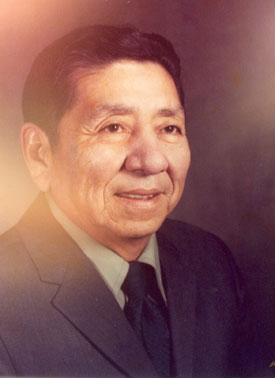
Vincent Malnourie was born on the Fort Berthold Indian Reservation on March 21, 1910. His parents were Charles and Daisy Little Sioux-Duckett Malnourie. He graduated from high school at the Sherman Institute in Riverside, California in 1932. He was married, and served in the United States Navy during World War II. He worked for the Bureau of Indian Affairs for 30 years and retired in 1968. Vincent was active in Fort Berthold tribal affairs and upon his retirement was elected tribal chairman of the Fort Berthold Indian Reservation and served two terms.
As chairman, he negotiated on behalf of the tribe on the proposed terms of settlement of several of the Three Affiliated Tribes claims pending before the Indian Claims Commission. His administration initiated the construction of the Mandaree community hall, utility building at Dragswolf Village, and construction of Phases I of the Four Bears Park. In 1973 he supported the legislation establishing a historic site out of the Knife River Indian villages near Stanton, North Dakota. (Delegation to Give Support, 1973)
He also worked for several years in a reservation alcohol program. He was a member of the Sahnish Traditional Dead Grass Society and held one of the singing sticks for the society. Another Sahnish Indian society that Vincent worked hard to revive was the Old Scout Society. This society actively honors the deceased Sahnish Indian scouts on Memorial Day in the community of White Shield, North Dakota, “Home of the Sahnish Tribe.”
Vincent was an accomplished and well-known Sahnish Indian singer and grass dancer, and was noted for his ability to lead in cultural events and activities. He worked hard to revive and retain the Sahnish culture for his people which he felt was fast disappearing with each new generation. He died in February of 1979.
RALPH WELLS, JR. (Nahaa nAE - Good Dish)
Sahnish, 1970–1971
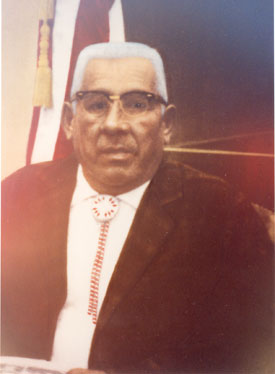
Ralph Wells, Jr. was born August 15, 1908 at Elbowoods, North Dakota, the son of Polly Plenty Fox and Ralph Wells Sr. He grew up at Lucky Mound and was educated at the Congregational Mission in Elbowoods. He attended school at Santee, Nebraska and Flandreau, South Dakota. He married Olive Sherwood in 1926, and they farmed and ranched at Lucky Mound prior to his becoming active in reservation politics. They raised five sons and two daughters.
Ralph Wells, Jr. served five terms on the Tribal Business Council, serving as treasurer, secretary, and tribal chairperson. He was well-respected, a strong supporter of education, and was an active community leader.
He was also an outstanding singer and speaker. He composed Sahnish songs that are still sung at celebrations today. He died while in office at the age of 62. He was well respected for his work in preserving the heritage and culture of his people. (Case, 1977)
NATHAN LITTLE SOLDIER
Sahnish, 1971–1972
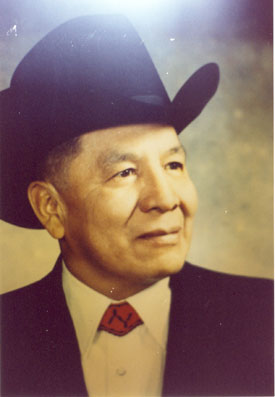
Nathan Little Soldier was born April 2, 1919, at Beaver Creek. His mother’s name was Willena Young Bear and his father’s name was Clarence Little Soldier. He attended schools at Wahpeton, North Dakota; Pierre, South Dakota; Santee, Nebraska; and Elbowoods, North Dakota. He was married to Rosella Hall on October 16, 1938. They raised three sons: Dale, Shote, and Arby. He served in the U.S. Army in Europe during World War II. Following his discharge, he farmed and ranched at Beaver Creek. (Nathan Little Soldier, 1980)
He was elected to the tribal council in September of 1971 representing the Southern Segment. He filled the vacant seat of Ralph Wells Jr. He served as chairperson until August of 1972. He also served on the council for a number of years, representing the Twin Buttes community and served on numerous committees. He was particularly opposed to destruction of the land by strip mining interests. (Selection is Planned, 1971) He was prominent in North Dakota rodeos, participating as a calf-roper. He died in August of 1980 at the age of 61.
ROSE CROW FLIES HIGH (Eda-awa-ge’dah)
Back to Earth (Mia-edugaah) Woman About Everything
Hidatsa, 1972–1973, 1974–1978
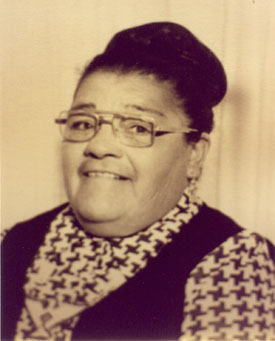
Rose Parshall was born on the Fort Berthold Indian Reservation to George and Ruby Parshall. She married George Crow Flies High, a son of Chief Drags Wolf in 1930. They raised a family of ten children, eight daughters and two sons.
In 1968, she was elected to the Tribal Business Council for the West Segment. She became the first woman elected by popular vote to the Three Affiliated Tribes tribal government, and the first woman to serve as chairperson. She was elected chairperson of the tribe in September of 1972 and served two months. However, the election was overturned in an election dispute. (Copeland, Tribal Election, 1974) She was later elected and served as chair from 1974 to 1978. In addition to her council duties, she worked as a social worker.
She was a strong advocate of the needs of the people. She supported the housing program at Fort Berthold, and was instrumental in the construction of the Minne Tohe Health Center on the reservation. She helped plan and participated in the Poor Peoples’ March on Washington, D.C. in May of 1968. (Indian Leaders, 1976) She served on many boards including the American Indian Travel Commission, the United Tribes Board of Directors, the Four State Health Board, and Plainswoman, a monthly newsletter headquartered in Grand Forks, North Dakota. (Publication for Women, 1977) Rose Crow Flies High died in January of 1994. (Rose Crow Flies High Obituary, 1994)
AUSTIN GILLETTE (Tsu Daga – White Shield III)
Sahnish/Hidatsa, 1978–1982
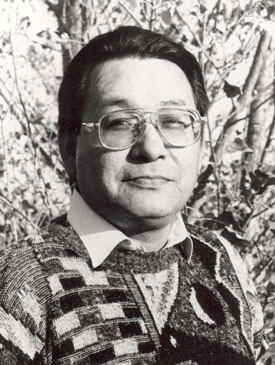
Austin Gillette was born in Minot, North Dakota on September 20, 1946. His name is “Tsu Daga” (White Shield III). His parents are Evan and Evadne Baker Gillette. In 1952, he attended first grade in Elbowoods, North Dakota, and graduated from Immaculate Conception High School in Stephan, South Dakota in 1964. He joined the United States Marine Corps in 1966.
He received a Bachelor of Arts Degree from Minot State University in 1972 and a Masters Degree in counseling and guidance from the University of North Dakota, Grand Forks, in 1974. Gillette was the first college graduate to serve on the tribal council and the youngest person elected tribal chairperson, when he was elected in 1978 at the age of 32. He is currently the longest serving member (20 years) of the tribal council.
During his tenure as chair and councilman, he was involved in establishing Fort Berthold Community College, and wrote judgment plans for claims against the federal government that provided for permanent funding to the tribe. These funds provide an appropriation of approximately $800,000 for education, economic development, land purchases and the tribe’s burial fund. (Turosak, Charting a Path, 1981) He was responsible for performing land appraisals on tribal allotted land on the reservation versus non-Indian lands on/off the reservation. These findings were used to substantiate JTAC legislation.
He established permanent funding of nurse practitioners for the White Shield and Mandaree districts in 1982. His administration coordinated and secured matching funding for the tribe’s Cattle Re-lending Program, construction funds for Fort Berthold Community College, community buildings in Twin Buttes, Parshall, and the North segment; purchase of the LCM Lumber Company, and matching funds to establish Mandaree Electronics. (A. Gillette, personal communication, August, 1998) Under his leadership, in 1982, he initiated minerals restoration, a loss resulting from the construction of the Garrison Dam. His administration was also responsible for securing management of the tribes’ natural resources.
He is active in the Young Hawk Bear American Legion Post 253. He has served as the post’s Commander. He represents the Eastern Segment on the tribal council.
ALYCE SPOTTED BEAR—Mandan, 1982–1986
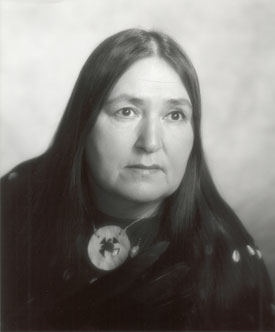
Alyce Spotted Bear, in 1982, became the second woman to be elected to the business council of the Three Affiliated Tribes. She completed her elementary and high school education at Stephan Indian Mission School in South Dakota. She earned a Bachelors of Science in Education at Dickinson State University and a Masters of Education from Pennsylvania State University, College Park, Pennsylvania. Returning home, she worked in education for the tribe and was the tribe’s personnel administrator.
At the age of 37 she became chairwoman, and led tribal governmental reform through a constitutional revision that reasserted the Tribal Business Council’s authority to exercise jurisdiction over the reservation and its people. (Tribal Votes, 1985)
During her administration, tribal scholarship monies were made available to students attending the Fort Berthold Community College. Her administration initiated the move for just-compensation for lands that the Three Affiliated Tribes lost to construction of the Garrison Dam, ultimately resulting in the tribes being congressionally awarded compensation of $149.2 million. (Ex-Tribal Leader’s Effort, 1992) Spotted Bear’s administration spearheaded the passage of the Mineral Restoration Act, by which Congress returned to the tribe minerals taken from them when tribal lands were flooded under the 1944 Flood Control Act.
During her term, the Three Affiliated Tribes became one of the leading tribes in the nation in the area of environmental concerns. The tribe monitored its ground water, air quality, and began a reservation-wide, solid waste removal program. The tribe also developed a municipal, rural, and industrial water (MR and I) system plan for which they ultimately received funding. (The tribe received favorable rulings in two United States Supreme Court cases).
Her administration also saw the initiation of the Buffalo Project, which today comprises a herd of nearly 400 bison. Spotted Bear was a visiting scholar-in-residence at Dartmouth College and is completing a dissertation for a doctoral degree, Cornell University, Ithaca, New York. (A. Spotted Bear, personal communication, June 1997)
1986-Present
Tribal Leaders, 1968 - Present
EDWARD LONE FIGHT (Sakaka Sake) Good Bird
Hidatsa/Mandan/Arikara, 1986–1990
Edward Lone Fight was born on May 28, 1939 to Maybelle Good Bird and Theodore Lone Fight. Theodore Lone Fight is a descendant of the Four Bear (Mandan). His paternal grandmother is Mary Young Bird Lone Fight. He is the grandson of Edward Good Bird and is a great grandson of Buffalo Bird Woman.
Edward graduated from Mandaree High School as salutatorian in 1959. He attended Dickinson State University and graduated with a Bachelors of Science with a double major in science and physical education. He was admitted to the Dickinson State Athletic Hall of Fame in 1989. He received a Masters Degrees in Education from Arizona State University, Tempe, Arizona and a Masters in Public Administration from Portland State University, Portland, Oregon.
His career with the Bureau of Indian Affairs extends over twenty years. During his years with the Bureau of Indian Affairs, he served in various capacities in Fort Yates, North Dakota; Phoenix, Arizona; Salem, Oregon; Anadarko, Oklahoma; and Washington, D.C. He was appointed by the Assistant Secretary of the Interior to serve on a national Indian School Equalization Fund Task Force, the purpose of which was to devise an equitable funding formula for all BIA funded schools nationwide.
In 1986, he was elected chairperson of the Three Affiliated Tribes. Accomplishments of his administration include repatriation, establishment of tribal services including the funding of a dialysis center, diabetes program, solid waste disposal system for the reservation, funding for the creation of Mandaree Electronics, and LCM (Lumber, Construction, and Manufacturing) Co. It was under his administration that final negotiations were concluded and the Just Compensation Bill was introduced based on the findings of the Joint Tribal Advisory Committee (JTAC) for lands taken under the Garrison Diversion Project. From 1994–1998 he served as tribal program’s manager for the Three Affiliated Tribes. He retired as Superintendent at Mandaree School, Mandaree, North Dakota in the spring of 2000. He is currently living in Billings, Montana.
WILBUR WILKINSON
Sahnish/Hidatsa, 1990–1994
Wilbur Wilkinson was born on October 12, 1948 to Ernest and Molly Wolf Wilkinson. He is a descendant of Spotted Tail and Wolf Lies Down. His fraternal grandfather was Mahlon Wilkinson, the first permanent Indian agent at Fort Berthold. He is a member of the Flint Knife Clan, three Clans, and four Clans.
He attended Haskell Junior College (now Haskell Indian Nations University); Northeastern University at Tahlequah, Oklahoma, and the University of Oklahoma, Norman. He was employed by the Bureau of Indian Affairs at New Town, North Dakota as credit officer, contract specialist at Sisseton, and administrative officer and superintendent at the Crow Creek Reservation, South Dakota. He was also administrative manager of the Tohono Oo’dham Nation at Sells, and superintendent at Tuba City and assistant area director of Window Rock Agency, Window Rock, all in Arizona.
He was elected to the Tribal Business Council in 1990 and served as chairman of the tribe through 1994.
RUSSELL “Buddy” MASON
Hidatsa/Mandan/Sahnish, 1994–1998
Russell “Buddy” Mason was born in Elbowoods in 1936, the son of Cecelia Mason Brown and Victor Mason. He was given the name of “Buffalo Boy” by his grandfather, William Deane. He attended Elbowoods elementary and high school and graduated from New Town High School, New Town, North Dakota.
Russell Mason joined the Armed Services in 1955, and was honorably discharged in 1959. He became involved in alcoholism treatment and prevention initiatives with Native Americans while attending the University of Iowa and Black Hills State College. He became the first Native American formally trained and certified in the field of alcohol and drug abuse.
In the 1970, under the aegis of the Bureau of Indian Affairs, he developed a national alcoholism awareness initiative, the intent of which was the development of drug and alcohol abuse and prevention programs for tribes and tribal entities. He served as the interagency liaison for the Commissioner of Indian Affairs on alcohol and drug abuse issues.
In 1978, he was appointed by the Director of Indian Health Services to develop and direct the Indian Health Services National Alcoholism and Drug Abuse Programs. During his tenure, he worked with Congress on the development of major legislation relating to national and state Indian alcohol abuse initiatives. He received several awards from the Department of Health and Human Services for exceptional performance for his contributions to the alcohol and drug abuse prevention field.
He returned to the Fort Berthold Reservation in 1992. Encouraged to seek office, he was elected to the Tribal Business Council in 1994 representing the New Town District. He served as tribal chairman on a platform to reestablish credibility in tribal government and to recreate a government that was more effective, accountable, and acceptable by the enrolled members of the Three Affiliated Tribes, a philosophy, he believed, could be translated into improved services for the tribe. During his administration, he returned financial stability to tribal government and instituted fiscally sound accountability measures within tribal government.
His extra leadership activities included serving as vice-president of the National Congress of American Indians, chairman of the Aberdeen Area Tribal Chairman’s Health Board, and chairman of the United Tribes Board of Directors. (Russell Mason. Personal communication, September 1995 and November 1998) Russell “Buddy” Mason died at Parshall, North Dakota on January 14, 2009.
MARCUS LEVINGS Eah-Bah-Dah-Gish or White Head Eagle
Hidatsa, November 2006–2010

Marcus Levings is from the Knife Clan which is a part of the Three-Clan people of the Hidatsa. He is a blood descendant of all Three Tribes: the Mandan, Hidatsa, and Arikara. He is the son of Marcus Wells, Sr. and Rezilda (Brady) Wells. His maternal grandparents are the late Carrie Driver-Brady and the late Glen Fox. His paternal grandparents are the late Adele (Levings) Wells and the late William Wells, Sr. Wells also carries the traditional Hidatsa name of “Mo-zah,” which translates in the English language to “Coyote.”
Wells successfully campaigned for the position of Three Affiliated Tribes Chairman during the Tribal General Elections held November 7, 2006, defeating his opponent by 233 votes. Wells said he believed it was time for a change that major changes in a positive direction needed to happen to insure the survival of the tribal people as a sovereign (self-governing) Three Affiliated Tribes.
Wells is a proud husband to Alvina (Crows Heart) Wells and is also the proud father of Dominick, Shawna, Alyssa, Mariah, and Marc William. Wells is a 1984 graduate from New Town High School, in New Town, North Dakota, and also graduated from Bismarck State College in 1986 with an associate’s degree in Business Administration. In 1988, he completed his bachelor’s degree in Business Administration and Finance from Dickinson State University in Dickinson, North Dakota, and in May 2002 obtained his master’s degree from the University of Mary, Master’s in Management program.
Chairman Wells in coordination with the Tribal Business Council has outlined five major priorities for the Three Tribes and include: (1) a proposed health care facility project, (2) a return of the lakeshore (24,000 acres) from the U.S. Corps of Engineers, (3) a federal trust responsibility—To date the federal government’s responsibility since 1998 to the Three Tribes totals $26.3 million, (4) Fort Berthold rural water, and (5) a proposed Fort Berthold oil refinery. (www.mhanation.com, 2009)
TEX G. HALL “Red Tipped Arrow" (Ihbudah Hishi)
Hidatsa, 1998–2006, 2010–2014
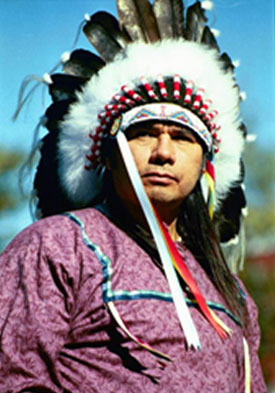
Tex G. Hall, was born on September 18, 1956 to Leland Hall Sr. and the late Audrey Rabbithead Hall. His higher education includes a B.A. from the University of Mary, Bismarck, North Dakota, a M.A. from the University of South Dakota, Vermillion, South Dakota, and 80 hours toward a Doctorate from the University of South Dakota, Vermillion, South Dakota.
Before entering politics, he was a cattle and buffalo rancher. He was also superintendent and principal of Mandaree School from1985 to 1996. In 1995, he was awarded North Dakota Indian Educator of the Year, by the North Dakota Indian Education Association.
He was elected to the Tribal Business Council, West Segment Representative—1996 to 1998. In 1998, he was elected as Chairman for Three Affiliated Tribes in a 1998 precedent-setting election. This was the first time in the history of the tribe a sitting council representative was elected to the Chairmanship.
He has served on numerous boards including being unanimously re-elected for a second term of the Great Plains Regional Tribal Chairman’s Association (a 16 member tribal organization composed of the elected chairs and presidents of the tribes in the Great Plains Region)—1998–2000; Secretary/Treasurer of the Board of Directors, United Tribes Technical College; member Aberdeen Area Tribal Chairman’s Health Board; delegate—National Indian Health Care Steering Committee assisting in the development of the budget for the Indian Health Care Improvement Act—1999; co-chair of National Tribal leaders Land into Trust, Tribal Task Force; and co-chair of National Tribal BIA Budget Task Force creating a Special Funding initiative for Indian Tribes of $7.4 Billion for 2001 Budget.
More recently, he chaired a May 12, 1999 meeting with President Clinton and Great Plains Tribes at the White House on Indian Treaty Issues, and co-chaired the Indigenous Summit of the Americas, March 2001 in Ottawa, Canada. In January of 2000, he was elected Chairman of Twin Buttes Custom Homes, Board of Directors and elected Chairman of Native American Bancorporation, April 26, 2000.
He was inducted into the North Dakota Sports College Hall of Fame in April of 1999. He has created Lifeways Village, a non-profit company for advancing economic development in Mandaree community. On November 30, 2001, he was elected to serve as president of the National Congress of American Indians, the oldest Indian Organization in the country.
MARK N. FOX
Mandan, Hidatsa and Arikara Nation, 2014–present
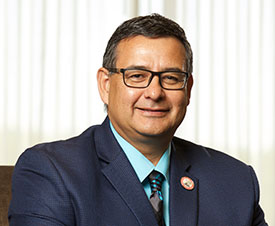
Mark N. Fox was born in Minot to Isaac and Virginia (Thorson) Fox in 1962 and raised in Parshall. He is a graduate of Parshall High School. Beginning in 1985, he served four years in the U.S. Marine Corps. Fox earned both his undergraduate and law degrees from the University of North Dakota. He has one son, Elijah, in addition to numerous adopted relatives and family members.
A dedicated advocate of tribal sovereignty, Fox was first elected chairman of the Mandan, Hidatsa and Arikara Nation in 2014, winning re-election in 2018 and 2022. In this role, he has promoted and enhanced tribal infrastructure, implemented long-term economic sustainability, and facilitated transparency in governmental affairs.
Fox is known for his leadership in the areas of tribal economic development, education, health services, taxation, energy, and gaming. He previously served as treasurer and vice chairman on the MHA Nation Tribal Business Council, as vice chairman of United Tribes Technical Center and the United Tribes of North Dakota, and as chairman of the Coalition of Large Tribes.
Nationally, Fox currently sits on federal advisory boards for the Department of Energy, Department of the Interior, and the Environmental Protection Agency. He has also advised the Internal Revenue Service and the National Indian Gaming Commission, chaired the Intertribal Monitoring Association on Trust Funds, and spent four terms as treasurer for the National Indian Gaming Association.
In 2022, Fox was inducted into the Native American Hall of Honor.
